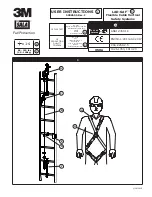
7
Cable types approved for use with the Lad-Saf
™
X2 Detachable Cable Sleeve
Description
ANSI, CE, CSA
Cable Part
Number
Material
Minimum
Breaking
Strenth
(lbs/kN)
Weight
(lbs/kg)
Operating temp
range
(°F/°C)
Max
Min
Cable - 3/8" (9.5mm) 1x7
*6104XXX /
CE 6134XXX(m) Galvanised Steel
15,400/68.4
0.27/ft-0.41/m 140/60 -40/-40
Cable - 3/8" (9.5mm) 1x7
*6105XXX /
CE 6135XXX(m) Stainless Steel
18,000/80
0.27/ft-0.41/m 140/60 -40/-40
Cable - 3/8" (9.5mm) 7x19 *6106XXX /
CE 6136XXX(m) Galvanised Steel
14,400/64
0.27/ft-0.41/m 140/60 -40/-40
Cable - 3/8" (9.5mm) 7x19 *6107XXX /
CE 6137XXX(m) Stainless Steel
12,000/53.3
0.27/ft-0.41/m 140/60 -40/-40
*Last three digits represent cable length.
1.2 LIMITATIONS:
The Lad-Saf
™
X2 Detachable Cable Sleeve must be used with a 3M Fall Protection approved ladder safety
system. Use only a 5/16 inch (8mm) or 3/8 inch (9.5mm) diameter solid core cable with the Detachable Cable Sleeve.
The safety system must have a maximum angle of 15° from vertical.
;
OSHA 1910.29 and OSHA 1926.1053 state that the length of connection between the carrier and
attachment point must not exceed 9 inches (23 cm).
2.0 SYSTEM REQUIREMENTS
2.1 COMPATIBILITY OF COMPONENTS AND SUBSYSTEMS:
This equipment is designed for use with DBI-SALA approved
components and subsystems. The use of non-approved components and subsystems (i.e. harnesses, lanyards, etc.) may
jeopardize compatibility of equipment, and could affect the safety and reliability of the complete system. If you have
questions on the installation or suitability of this equipment for your application, contact 3M.
WARNING: USE OF CLIMB ASSIST SYSTEMS THAT ARE NOT COMPATIBLE WITH 3M VERTICAL LIFELINE
SYSTEMS CAN RESULT IN SERIOUS INJURY OR DEATH. D
o not use a powered climb assist (PCA) with a 3M climbing
ladder fall arrest system (CLFAS), including the Lad-Saf vertical lifeline system and Lad-Saf X2, X3 or X3+ detachable
cable sleeves, unless the PCA has been verified by 3M as being compatible with 3M’s CLFAS. Failure to comply with this
warning could result in a user’s fall not being safely arrested in the event of a fall from height while using incompatible
PCA and CLFAS systems. Contact 3M Technical Service at [email protected] with any questions.
2.2 COMPATIBILITY OF CONNECTORS:
(See Figure 4)
;
Use only supplied connectors.
Connect carabiner (
A
) to frontal D-Ring (
B
).
2.3 MAKING CONNECTIONS:
(See Figure 5)
3M Fall Protection snap hooks and carabiners
should not
be connected:
A.
To a D-Ring to which another connector is attached.
B.
In a manner that would result in a load on the gate.
C.
To each other.
;
Ensure all connectors are fully closed and locked
.
3.0 OPERATION AND USE
3.1
LAD-SAF
™
SYSTEM USE:
BEFORE EACH USE
inspect the system and cable sleeve according to section 5.0.
Verify from the label markings that the system has been formally inspected within the last year.
DO NOT USE
an
improperly maintained Lad-Saf
™
system and
DO NOT CLIMB
a structure that is not in good condition. Inspect the
detachable cable sleeve according to Section 5.3. Inspect the full body harness according to manufacturer’s instructions.
Inspect the Lad-Saf Safety System according to Section 5.4.
3.2 PLAN
your use of the Lad-Saf
™
system
before starting work
. Consider all factors that will affect your safety
before
starting your work
.
•
Ensure the system is rated for the required number of users.
•
There are hazards associated with connecting and disconnecting from the system. Use secondary fall arrest
protection. Ensure adequate anchor points, landing platforms, or other means are available at connection and
disconnection points to allow safe transitions to and from the system.
•
A minimum fall clearance of 7 ft. (2 m) is required between the user’s feet and surface below. The user may not be
protected against hitting the ground or landing during the first 7 ft. (2 m) of ascent or last 7 ft. (2 m) of descent.
Use proper climbing procedures (e.g., maintain 3 points of contact with hands and feet) when ascending or
descending any portion of the ladder unprotected by the Lad-Saf
™
system.
•
Use proper safety procedures when climbing. Do not carry tools or equipment by hand. Keep your hands free for
climbing. Secure carried items to avoid dropping them on climbers below. Climb within your ability. Long climbs may
require several rest stops during ascent or descent to avoid exhaustion. Use proper work positioning equipment for
rest breaks. DO NOT climb in high winds or severe weather.
•
Ensure only one user is climbing between cable guides.
Summary of Contents for DBI SALA LAD-SAF
Page 3: ...3 8 9 C G L D 10 11 G C A D E 2797 1 2 3 4 5 6 7 8 9 11 9 9 9 10 ...
Page 101: ...100 ...
Page 209: ...208 ...
Page 218: ...217 ...








































